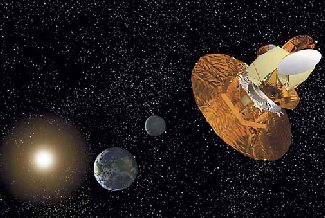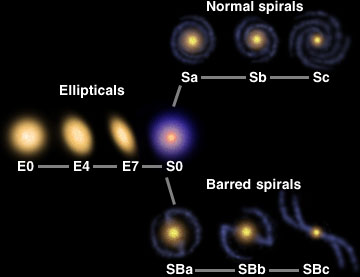Click on image for full size
Courtesy of the MAP Science Team, NASA
Related links:
Capturing the Afterglow of the Big Bang
News story originally written on June 25, 2001
According to the Big Bang theory, the universe began about 12-14 billion years ago. Right after the Big Bang, the universe was really hot! But, as the universe has expanded, the particles within the universe have cooled. There is a radiation that fills the universe, called
Cosmic Microwave Background Radiation (CMB). CMB radiation is literally the remnant heat left over from the Big Bang. The CMB radiation that can be tracked today is very cool; it is only ~2.73 degrees Kelvin (degrees above absolute zero). CMB radiation is everywhere! If we could see in the microwave segment of the electromagnetic spectrum, we would see CMB radiation everywhere! And the CMB radiation would glow with a brightness that was almost uniform across the whole universe!
The MAP (Microwave Anisotropy Probe) will be launched June 30, 2001. It is so precise that it will be able to measure differences in cosmic microwave background radiation even better than the COBE probe before it. Anisotropy simply means measuring the differences in temperature from cosmic microwave background radiation from different directions. So, radiation from one part of the sky might be 2.7251 degrees Kelvin and radiation from another part of the sky might be 2.7249 degrees Kelvin. MAP can measure differences even to a millionth of a degree! "Nothing has ever been built like it before," said Dr. Edward Wollack, a science team member at Goddard. "To measure the cosmic glow reliably to a part in a million, to millionths of a degree has been the grand challenge. That's like measuring the weight of a cup of sand down to the resolution of a single grain."
"The cosmic microwave light is a fossil," says Professor David T. Wilkinson, Princeton University, Princeton, NJ. "Just as we can study dinosaur bones and reconstruct their lives of millions of years ago, we can probe this ancient light and reconstruct the Universe as it was about 14 billion years ago." By mapping CMB radiation emission, scientists are hoping to see into the past so that they might answer questions such as these: What happened during the first instant after the Big Bang? How did the universe evolve into the complex patterns of galaxies that we see today? Will the universe expand forever or will it collapse? Is the universe dominated by exotic dark matter? What is the shape of the universe?
The MAP probe will be launched on a Delta II rocket from Cape Canaveral, FL. It will swing past the Earth 3-5 times and then swing past the Moon, using the Moon's gravity to maneuver to the L2 Lagrange point. MAP will reach the L2 point in about 3 months. While remaining in orbit around the L2 point, 1.5 million kilometers from Earth, the probe will take about 18 months to do a full-sky survey of CMB radiation.















